Fotograafia BA I, kunstiprojekt
Õppejõud: Laura Kuusk ja Camille Laurelli.
Kursuse eesmärk oli anda fotograafia 1. kursuse tudengitele ja erasmus-tudengitele isikliku kunstiprojekti tegemise kogemus. Kursus toetus taaskäivitamise (re-boot – inglise k.) ja taaskasutamise (re-use- inglise k.) ideele. Tudengid tutvusid taaskasutuse, kontekstualiseerimise ja apropriatsiooni mõistetega kunstipraktikas. Toimusid visiidid Eesti Rahvusarhiivi Filmiarhiivi ja Sirbi ajalehe arhiivi. Õpilased töötasid avalike digitaalselt kättesaadavate arhiivide põhjal.
Ühiseks teemaks erinevatele 2-3-liikmelisele gruppidele on “(Rahva)hulgad”. Selle katusteema all on tudengitel oma huvifookusega täpsem teema — metsapoliitika ja -majandus, laulupeo fenomen, avaliku ruumi kasutus Kesturu näitel, viiruse ja selle ravi visuaalne palendus läbi sajandi, meeleavalduste mahasurumine ja tsensuur õlitehase ja fosforiidisõdade näitel, lihatootmise ja -tarbimise visuaalne kujutamine.
Kursuse tulemusena valmisid tudengite arhiivimaterjalide põhjal teostatud tööd, mis väljendavad nende kunstnikupositsiooni valitud teemal.
Kursus toimus koostöös ajalehega Sirp. Valminud tööd lähevad Sirbi 80. sünnipäeva puhul avaldamisele. Kursuse jätkuna on plaanis on näitus Balti jaama ja Vabaduse väljaku tunnelis 2020.a. oktoobris.
ENG:
Professors: Laura Kuusk & Camille Laurelli
The task of the Art Project 1 class was to give the first year photography and Erasmus students the experiece to create a personal art project. The core notions the class was based on were re-boot and re-use. Students got acquainted to the ideas of reuse, contextualisation and apropriation in art practice. There were visits held to the Estonian National Film Archive and Sirp cultural newspaper archives. The students worked with digitally available public archives.
The common theme for the group was “Crowds”. Within this roof-subject, the students had their own focal point to a specific theme chosen by them — the forest politics and economy, the phenomena of song festival, usage of public urban space based on the example of Central Market, the image of virus and healing throughout the century, censure and repression on the example of Phosphorite wars and the new oil factory project in Estonia, meat production and consumption with its’ visual representation.
The works that result from the classwork express the artistic position of each author or group on the chosen subject.
The class has an extention through a cooperation with the newspaper Sirp. The works will be used as covers at the occasion of Sipr 80th anniversary. There is an exhibition planned for October 2020 in Baltic Market tunnel and Freedom Square tunnel.
Andra Junalainen
Virus
Digital Photography
Projekt “Viirus” on inimese ja viiruse suhtest. Kuidas ja mille kaudu me märkame viirust ning kuidas me sellega elame. Antud töö räägib kitsamalt inimestest, kes ei võta viirust liialt tõsiselt.
English:
The topic Laura, Elo and I chose were viruses. With the COVID-19 spreading, it seemed intriguing to research about viruses and how they are invisible, but at the same time made visible.
To do my research I mostly used Estonian National Archive Fotis, the newspapers archive Digar and ERR news portal.
I assumed to find something different from the main media flow but all I could come across were close-up photos of viruses, doctors, microscopes and crowds. It seems to be that only through these things we are able to visualise viruses.
I have collected some pictures that are possibly usable in my work further on. In my work I want to illustrate how it is to live with viruses, how we are able to see them around us and how they spread among the people. My work is targeted to the people who do not take viruses seriously.
Overall I do not see that the understanding of “virus” has changed much over the last centuries. It has become more scientific and intriguing to the media but people are still seeing it as a danger to their lives. In conclusion the concept of virus is still the same even if it has become curable in some ways and cases.
.
.
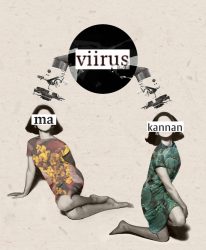
.
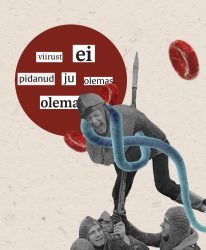
.
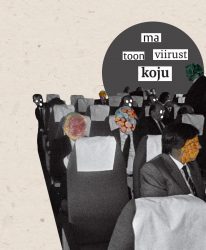
.
Kasutatud Materjalid:
Rahvusarhiiv, EFA.204.0.258789, autor: Mati Songisepp
Rahvusarhiiv, EFA.203.0.204679, autor: Oti Vasemaa
Rahvusarhiiv, EFA.250.0.45941, autor: Loss, G.
.
.
Elo Vahtrik
Viirus meie keskel
Digitaalne fotograafia
Projekti keskne idee on peegeldada COVID-19 pandeemia tagajärgi ja esitada küsimus, kuidas saada hakkama viirusega, kes on omavoliliselt tunginud meie süsteemi.
English:
Virus In Our System
Digital Photography
The topic Laura, Andra and I chose was virus. In the light of recent COVID-19 pandemic, it seemed interesting to do research about how something invisible to human eye, was and is portrayed in media.
It is believed that there are more viruses than stars in the universe. Not all of them are bad or deadly, for example bacteriophages are viruses that infect and destroy specific bacteria and are therefore good for us. However the discourse about viruses is and has been driven by rahther negative emotions. Virus is something we must kill, get rid of. Taking into account the recent events, something that disturbs our world, puts it on hold. It is speculated that the COVID-19 pandemic will not be the last or most devastating pandemic in the 21st century.
I primarily used research databases Sirp archive and FOTIS. In addition I also used some articles that focused on the Soviet propaganda posters from the last century.
I assumed to find some posters, or visually appealing photographs, that dealed with topics such as virus,pandemic and how people dealed with sicknesses overall. To my suprise, i only found few posters or images that featured the topic i was interested in, the way I expected.
After I broadened the use of keywords (not only virus, sickness, hospital but also doctors, health, healthcare etc), I found images that i could use in my work. My goal was to, in a way, re-use the pictures, taking them out of their context and shaping them into what i wanted them to be. I wanted to create a poster-like image, that is visually appealing and I wanted to use pictures or drawings of humans to represent the virus. Because, assuming that we live in a wellfare society, are the ones who can slow down or fasten the process of spreading the virus*. Since we dont know straight away, when a new virus is found, how to kill it, we must learn how to live with the virus in our system. By using the word system I refer to such systems as but not limited to healthcare, economic system, sociocultural system.
I think the context for the subject „virus/es“ has not changed drastically, when compared to the last century. Perhaps the visuals have become more scientific, more colourful, but that is the result of the development of better technology, not necessarily because of the discourse about it has changed . It still carries a sense of fear and mortality to it. It is argueably something we crave to control, but with varying degrees of success fail to do.
*referring to COVID-19
.
.
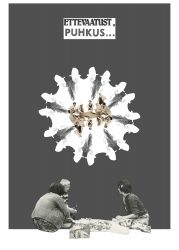
.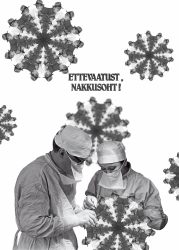
.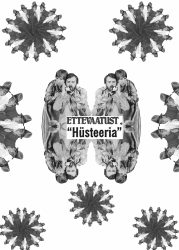
.
Kasutatud Materjalid:
Rahvusarhiiv, EFA.204.0.54266, autor: Norman, Erich
Rahvusarhiiv, EFA.204.0.124946 , autor: Vendelin, Jüri
Rahvusarhiiv, ERA.4944.1.16.121
Rahvusarhiiv, EAA.R-271.1.1226.26
.
.
.
Imbi Sõber
scarCITY
Digitaalne fotograafia
Teos kujutab avalikku ruumi läbi erinevate ajastute ja juhib tähelepanu selle kadumisele Tallinna Keskturu ja Kalaranna piirkonna näidetel.
English:
Markets in general have always appealed to me because of the interesting mix of people who visit these places. At the moment I am particularly interested in Keskturg since it is the last big market in Tallinn which has stayed authentic since the 1990’s. However it is about to change the same way as Balti Jaam market did a few years ago.
I started browsing through pictures in the photo collection of the National Archives of Estonia (FOTIS) and Information System of Estonian Museums (MuIS) from which the aerial photo of the Keskturg and its surroundings caught my eye. The photo shows Keskturg, before its main building, and how we are used to seeing it now. Comparing this photo to the project, according to which the Astri Group will build a new market, and reading articles in newspaper archives I found that the new market is planned to be only half of its current size and the rest of the land will be covered with apartment buildings. Although Keskturg has been privatized it is still counted as a semi-public place since people can access it freely.
This project reminded me of Kalaranna Kvartal, where similar changes with loss of public space is happening. I looked more into the area of Kalarand by going through the photos from FOTIS, Madis Veltman (DELFI) and Reio Avaste (LIFT11). Comparing these photos from different times, they illustrate the changes of Kalarand. According to the project plan of Pro Kapital the majority of the area will be covered by apartment buildings. Based on the new project plan the public access to the shoreline will be kept, but the public space will still be largely buried under the apartment buildings.
Despite the fact that the Keskturg and Kalaranna project detail plans involve landscaping it does not change the fact that a big part of these semi-public spaces is lost. It is important to consider the fact that Tallinn is a small city and there is no need to build more apartment buildings to the centre of the city than there already is, especially at the expense of public space.
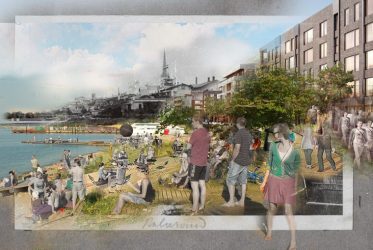 .
.
.
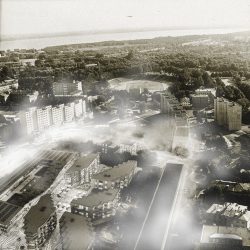
.
Laura Binggeli & Ivor Lõõbas
Kaotatud tulevik
Digitaalne fotograafia
Inspireerituna 1980ndate fosforiidisõjast, on töö keskmes Eesti valitsuse otsus investeerida täiendavad 125 miljonit eurot uue põlevkivi õlitehase rajamiseks vaatamata COVID-19 pandeemiast tingitud eriolukorrale ja sellega seoses kehtestatud piirangutele. Oluline on juhtida tähelepanu situatsioonile, kus hetkel vähetähtis ja kauakestva mõjuga otsus tehakse erakorraliselt ulatuslike poliitiliste volituste raames.
Kriisis jäävad kaotajaks järgmised põlvkonnad ja keskkond.
English:
Future Forfeited
Digital photography
This project started as a vague idea about finding traces of censorship in the Soviet era of Estonia from the Sirp1 and FOTIS2 archives exclusively. Soon, it became clear that censorship generally implies that something is missing or misrepresented. How do you look for something that is not there? How do you know if something is supposed to be there or if it is incorrect without an external point of reference?
Protest against the oppressing and censoring regime of the Soviet Union took the form of the Phosphorite War in the 1980s. Even though it was primarily directed against the plans to expand phosphorite mining, it was the start of the citizen insubordination movement in Estonia under the pretext of environmentalism and one of the steps that led to Estonia regaining independence.
On 12 March 2020 the Government of Estonia declared a state of emergency to limit the spreading COVID-19 pandemic3. During the state of emergency, on 26 March 2020 the Government of Estonia decided to invest 125 million euros into Eesti Energia to fund the construction of the new Enefit280 oil shale plant4. On 28 March 2020 a group of youth organisations wrote an open letter of protest against this investment5, on 26 April 2020 Fridays For Future Estonia tried to go to court to annul the permission for starting the construction6, and on 12 May 2020 an inquiry by 24 citizen organisations was sent to the Commissioners of the European Union regarding the investment7.
In view of the still-unfolding events, among the enforced restrictions and inability to bring protests to the streets, and inspired by the Phosphorite War of the 1980s, this work is meant to draw attention to the fact that in the present day, decisions that affect the environment that the future generations are going to live in, are being made in the state of elevated political power. This investment is a decision that need not have happened during the ongoing pandemic and the state of emergency.
In a time of crisis, future generations and the future of the environment are forfeit.
.
.
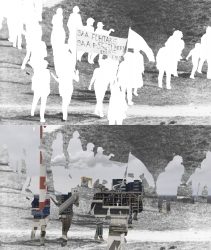
.
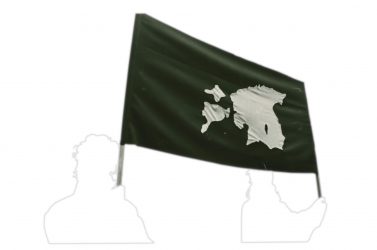
.
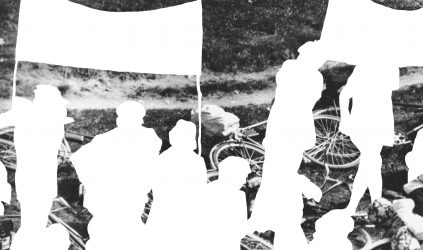
.
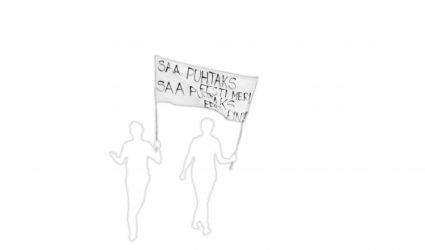
.
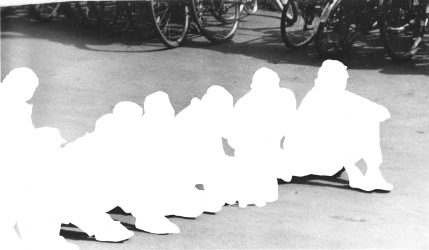
.
1 https://dea.digar.ee/cgi-bin/dea?a=cl&cl=CL1&sp=sirpjavasar and
https://dea.digar.ee/cgi-bin/dea?a=cl&cl=CL1&sp=sirp
2 http://www.ra.ee/fotis
3 https://www.valitsus.ee/et/uudised/valitsus-kuulutas-eestis-valja-eriolukorra-1-maini
4 https://www.valitsus.ee/et/uudised/valitsus-andis-eesti-energiale-rohelise-tule-uue-olitehase-ehituseks
5 https://www.facebook.com/fridaysforfutureeesti/posts/3536510186365788
6 https://www.facebook.com/fridaysforfutureeesti/photos/a.2848878855128928/3614613345222138/ and
https://www.err.ee/1083285/kliimaaktivistid-poordusid-olitehase-ehitamise-peatamiseks-kohtusse
7 http://www.kliimamuutused.ee/uudised/uhenduste-poordumine-euroopa-komisjonile-eesti-investeeringudpolevkivisse-lahevad-vastuollu-eli-toetustega
.
.
Laura Maala
Ettevaatust, viirus!
Plakat
Töö ajendiks said viimase sajandi vältel viiruste ning nakkushaiguste eest hoidumiseks loodud tekstid. Saja aasta kestel on idee viirustest jäänud samaks, kuigi tänapäevases infokülluses võiks eeldada, et meie teadmised on aja jooksul tohutult kasvanud.
English:
Beware – virus!
Poster
The topic Andra, Elo and I chose was viruses and how people have dealt with them throughout history also how are infectious diseases and their consequences portrayed in the media.
For my research I used the Estonian National Archive Fotis and also the online newspapers archive Digar.
I didn’t really assume to find anything because I wasn’t sure what kinds of images have found their way into the national archive. Also I’m not familiar with old newspapers so it was definitely an interesting experience flipping through them and finding out how they were put together and what they contained and what were the important topics covered.
I have found very little amount of image material on infectious diseases throughout Estonian history, however there was more text material on infectious diseases in newspapers including tips on how to stay healthy during a virus outbreak and statistics about the spread of the disease. To find materials I had to use a very broad spectrum of keywords as the word “virus” wasn’t used a 100 years ago (viruses were called “adhering diseases”).
Today we can see how the text and recommendations remain the same but how nowadays we have also added visual material when speaking about infectious diseases (some photos in the media but talking of prevention there is usually icons used). It’s interesting to see how the preventative measures have stayed the same for almost 100 years even though our knowledge about viruses has expanded a lot since then and we have better opportunities now to learn how viruses spread. The concept of virus has not changed.
.
.
.
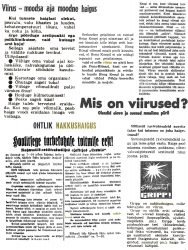
.
.
.
.
Markus Mikk
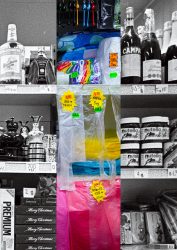
.
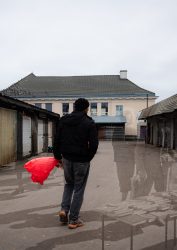
.
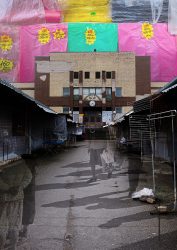
.
.
.
.
Meel Paliale
Deforestation
.
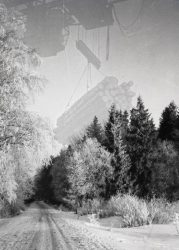
1. Why am I interested in the subject?
The topic is interesting to me because I am concerned about deforestation. Loss of
forests means loss of species. It also contributes to global warming. About 20 percent of
the world’s greenhouse gas emissions come from the clearing of tropical forests. Estonia
is perceived to be a very eco friendly country but in reality our forests are in the worst
shape they have ever been and managed by people who only care about money.
2. What materials/databases have I used for the research?
All of the images that were used I found from Fotis.
3. What did I assume to find?
My initial plan was to recreate soviet propaganda posters regarding
deforestation but when I found an article on postimees about the current state
of our forests by Fred Jüssi, I thought I would make my art project about that
instead.
4. What have I found or not found?
I was hoping to find pictures of beautiful estonian forests and also photographs of
deforestation and people destroying forests. After searching through a lot of photographs
I found what I was looking for.
5. What is the context for the subject today?
It is a well-known fact that deforestation is a huge problem. Right now it is important to
prevent taking down forests. Many countries are increasing their efforts in conserving
forests and more than 100 countries have established national forest programs to manage
forests more holistically. It is also important to note that forests can’t be restored.
Animals don’t like living in tree fields. In Ireland, you can see what a tree field is like.
Look there is no forest!
.
.
.
Meike Dietzel & Joosep Kivimäe
The Red Marble
Digitaalsed fotod
Rohkem kui kunagi varem on inimesed harjunud nägema liha poelettidel ilusti plastikusse pakendatult, meenutades vähimat sellest mis ta kunagi oli. Eirates täielikult mis tee läbi see sinna jõudis. Sea või lehma veristamises pole midagi hiilgavat — küll aga lihaveise marmor antrekoodis? Probleemi ära tundmisest on saanud omaette probleem.
English:
The Red Marble
Digital Photograps
Every ten seconds humans kill roughly 24 000 animals for food. In a year that adds up to 75 billion animals each year. Different studies have shown that meat production is a significant branch of industry that contributes to global warming. In fact, it is estimated that out of all the human “controlled” greenhouse gas emissions, animal agriculture contributes up to 20%. But we are not here to talk about that. Over the past quarter century, forests have been cleared from an area the size of India. Deforestation, especially in the tropical region, causes the loss of biodiversity which impacts the ecosystem accompanied by soil degradation. The entire act of destruction, from lush forest to an even cut wasteland takes up less than a decade but the environmental damage is largely immeasurable and will last for generations to come. But we are not here to talk about deforestation either. The animal farms have grown so big and are so concentrated in volume that the only way to keep the animals from getting sick is to feed them antibiotics.
Although there is no evidence that antibiotics in foods harm people directly, most agree that the overuse of antibiotics in food-producing animals is a problem. It can contribute to the development and spread of drug-resistant bacteria, which is a potential risk to public health. Also, antibiotics don’t work on viruses, which can make the jump from farm animals to humans — swine flu, bird flu etc. The scale of meat production reaching 75 billion animals a year is not sustainable.
“People need to wake up to the idea that animals take a very heavy toll on our lives in the environment.”
– Michael Specter
Overall meat consumption is on the rise
We have all seen glimpses of images from the inside workings of slaughterhouses and we have all the information about the effects on animals, humans and the planet. Our consumption goes on and we ignore all the facts that we know. But why is that? What we are going to argue is why the problem still persists and is getting worse because how much we have actually distanced ourselves from where and how meat comes from in the first place. It has become a problem of its own to even recognize that we have a problem. Advertisement plays a big role in this and definitely helps us to forget and ignore. What is being sold to the end consumer is not the meat itself anymore but a lifestyle. Now more than ever, people have become accustomed to seeing their meat only when it has been pristinely packaged in plastic on shelves of supermarkets, completely ignoring how it got there. There is nothing glorious about slaughtering a pig or cow — but what about marbled beef entrecote from Angus cattle?
.
Art Hall Showroom Display Window
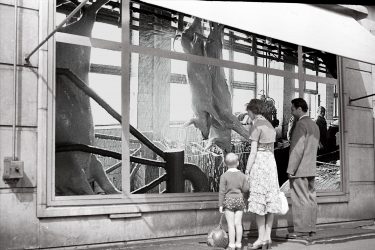
.
In Restaurant “Estonia” White Saloon
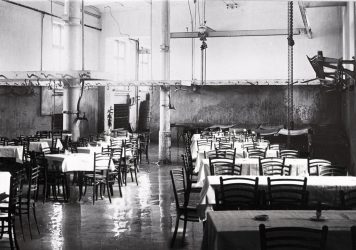
.
A Device To Clean Slaughtered Pigs
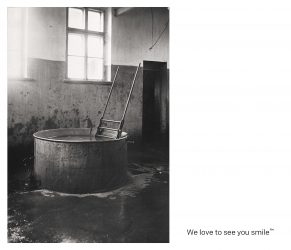
.
Tallinn Meat And Canned Food Factory Bird Killing Conveyor Belt
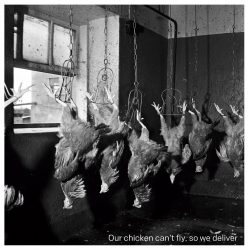
.
.
